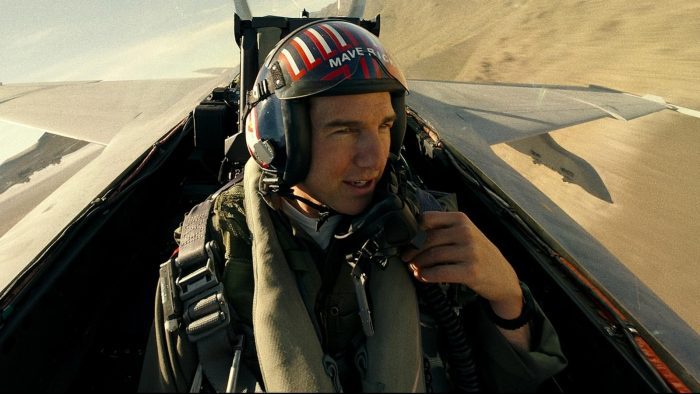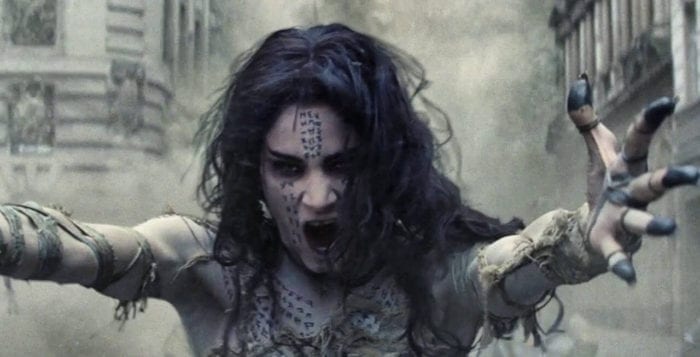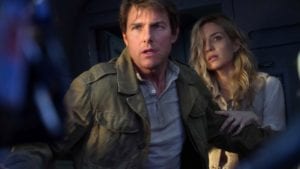Reviewed by Jeffrey Sanzel
In 1986, 24-year-old, pre-couch-jumping Tom Cruise was featured in a string of high-profile films: The Outsiders (1983), Risky Business (1983), All the Right Moves (1983), and Legend (1985). Poised for a breakthrough, his performance as rebellious Naval Aviator Pete “Maverick” Mitchell in Top Gun secured his stardom. The highest-grossing film of the year, it made over 350 million dollars worldwide.
Many critics found little to love outside of the aerial dynamics, but it became a pop culture hit, winning the Academy Award for Best Song, “Take My Breath Away” (music by Giorgio Moroder; lyrics by Tom Whitlock). Inspired by Ehud Yonay’s article “Top Guns,” the film’s screenplay (by Jim Cash and Jack Epps, Jr.) combined endless flight jargon with dialogue lifted from the lesser After School specials.
Peppered with clichés like “he’s a wild card” and “it’s not your flying, it’s your attitude,” the film lacked depth, subtlety, and even basic tension. The insufferably smarmy Maverick is not so much a character but the smirk of one. Outside of one “steamy” scene between Cruise and co-star Kelly McGillis, the homoerotic movie is populated by men in towels talking about the need to shower. Both misogynistic and juvenile, Top Gun made Risky Business seem emotionally sophisticated.
As early as 2010, a Top Sequel was in development. Finally, after years of delays, Top Gun: Maverick arrives 36 years after the original’s release. Instead of a clumsy sequel, the creators have forged a smart, entertaining, well-made film that is visually stunning. If the screenplay (by Ehren Kruger, Eric Warren Singer, and Christopher McQuarrie) is not exactly Citizen Kane, the storytelling is defined. The characters are simply drawn but true to the situation. There is an honesty and a general earnestness that harkens back to the better war movies of the 1940s. Joseph Kosinski has directed his actors to play the characters straight down the middle. There are not a lot of surprises, but the can-do spirit works.
Cruise’s Maverick is a much-decorated pilot but still a captain. For every commendation he has received, overstepping has prevented him from receiving a promotion. While his skills are never in doubt, his problematic behavior towards authority has not so much stalled his career but buried it. At the end of the first film, Maverick requested a position as a Top Gun trainer. He reveals that he only lasted two months.
The older Maverick is low-key but still rebellious, rankling his superiors. Rear Admiral Chester “Hammer” Cain (Ed Harris) tells him, “The future is coming. And you’re not in it.”
Maverick’s formal rival, “Iceman” (Val Kilmer), now commander of the U.S. Pacific Fleet, has called Maverick back to Top Gun. (Except for Cruise, Kilmer is the only holdover from the first film. He has a single scene where he mostly communicates by typing as the admiral has throat cancer.) The mission is to take out a rogue state’s uranium enrichment plant before it opens. Surface-to-air missiles and skilled fighter pilots protect the canyon. The only way to bomb the plant is to literally fly under the radar in a demanding, dangerous mission.
Vice Admiral Beau “Cyclone” Simpson (John Hamm) and Rear Admiral Solomon “Warlock” Bates (Charles Parnell) have gathered an elite group of fighter pilots for Maverick to train.
The plot is simple, with the sole complication that one of the pilots, Lt. Bradley “Rooster” Bradshaw, is the son of Maverick’s former radar intercept officer and best friend, Nick “Goose” Bradshaw (Anthony Edwards in Top Gun). While cleared of the responsibility for his pal’s death, Maverick still carries guilt, and he reveals that at the request of Goose’s widow (now dead—Meg Ryan in the earlier film), he has done everything to prevent Rooster from flying. Eventually, Maverick and Rooster come to terms with their joined histories.
A minor romantic subplot involves Maverick and a bar owner, Penny Benjamin (Jennifer Connelly), but it generates little heat or interest.
The film’s two driving forces are Cruise and the mission. Both Cruise and Maverick have aged well, and the general lack of arrogance makes for a watchable experience. As the writing is focused, the technical details are clear. The actors lean into the physical demands and challenges of the flying and the mantra that “It’s not the plane. It’s the pilot.” The cavalier comment in Top Gun—“A need for speed”—here actually makes sense. Everything builds up to a spectacular final act, with the operation beautifully orchestrated with the right amount of suspense and a couple of twists that help keep it interesting. The faceless, but ominous enemy, is smartly handled.
Top Gun: Maverick’s major song, Lady Gaga’s “Hold My Hand,” plays over the credits. It is an appropriate metaphor for the film. A bit schmaltzy but also effective, honest, and wholly satisfying.
Rated PG-13, the film is now playing in local theaters.







